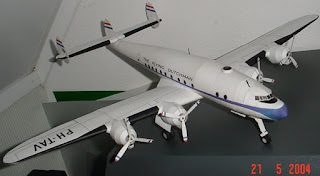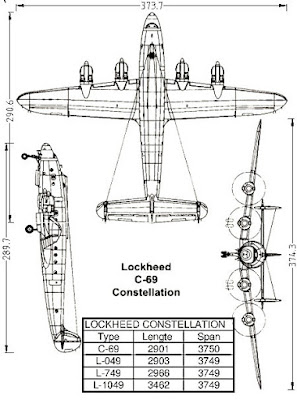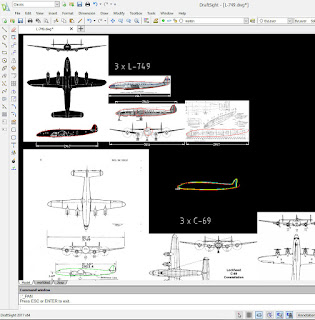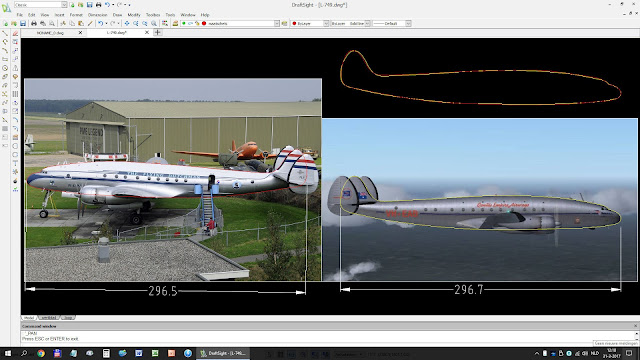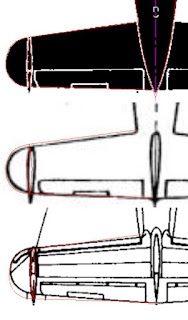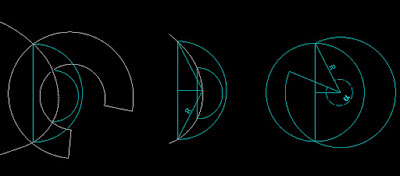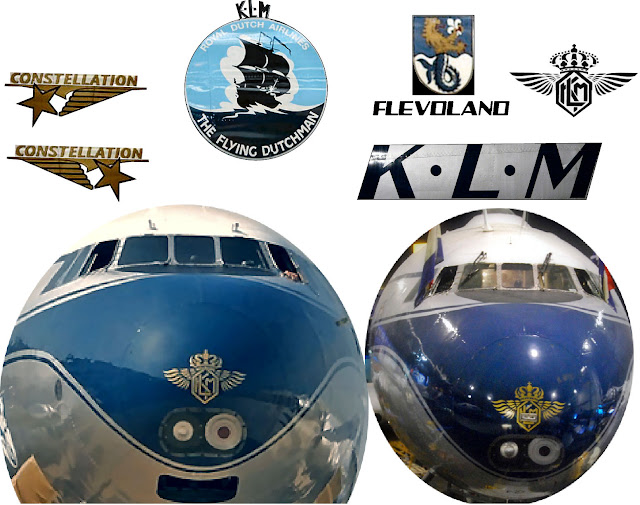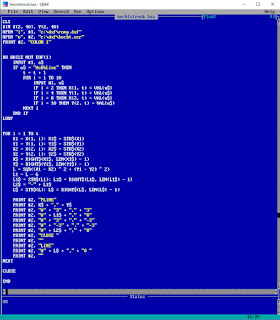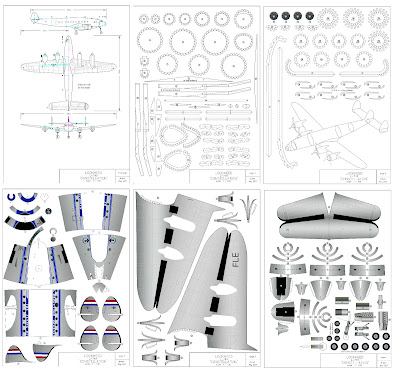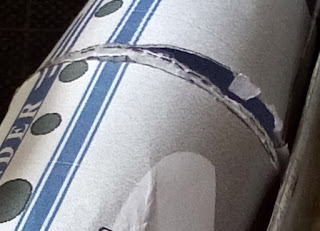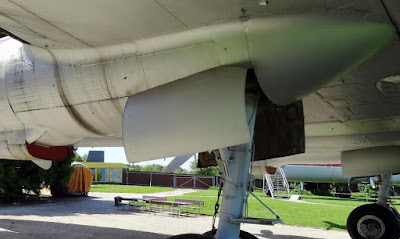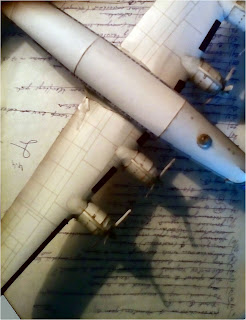He liked me to figure out the consequences.
 |
| the C-69 that the paper-modeler intends to build |
Working the reconstruction of both elements my thoughts went back to the first years of this century when I drew this plane before. I remembered the seize of
the model on a much too big scale causing irrepairable damage during removal.
And then, triggered by that nostalgic touch and the recently purchased knife-blades and flask of glue in the open desk drawer at the left, I Googled along all these attractive Connie-pictures... Such an amount of good-looking 3Views...
ok then, there we go!
 |
but since there's no distance between
being trusting and being the fool
|
I decided to believe the owners of being the Aviodrome's Connie a type 749 and collected all available profiles of Constellations with 9 to 11 round windows.
Inserting the shape of the body, derived from the previous 3Views, on all these pictures convinced me that all 3Views are, in spite of their captions, no L-749's.
This applies on the photograph on top-right too where the 3view-shape fits in perfectly. Consequently I will have too create my own L-749 3View only by means of photographic sources. A hell of a job and I secretly doubt having used wrong 3views on the 2004-model as well...
In that case, fortunately she's gone.
Well let's have a look how far the 3views deviate from the L-749 available pictures. Therefore I've drawn a new (green) line over the outer contours of the bodies and finally measured the amount in order to get an idea about the reliabillity of photographic material on the drawing of a new 3view.
Fortunately there is a perfect side-view of the Aviodrome's FLE available on the internet.
 |
| differences between 7 available 3views and the Aviodrome's L-749 |
Multiplying the red shape by the body-length factor (1.167 or 1.193 for the L-749 or C-69/L-049) should then result in at least the same body-width.
De deviation says something about the 3view quality in general.
Now the shape of the fuselage is ok let's have a look at the wing(s).
De deviation says something about the 3view quality in general.
The lack of reliable L-749 3views leads me to refer to the C-69, the only nearest 3view.
The major problem now is to figure out where to find the 65cm of body length as well as the influence of this extension on the position of the wings.
Finally I traced three C-69 and another three L-479 3views.
Compairing these drawings the half a meter difference in length was not to be found in the nose but somewhere in the fuselage and obviously of no account for the model.
Divergences between the 3views can probably be solved with the photograph-traces.
Perfect !
Now I have found the most reliable side view of the L-749 only the top-view remains to be checked. Since there is no photographic material of the top-view on the internet nor a silhouette from below my only reference is one simple 3view and a picture of a plastic model.
Usinng these two I found the following outlines:
 |
| that should do |
The span is the easiest to check and again we stumble across the unreliability of
3views...
Maybe the 3view wing was still o.k.
Having moved the portside wing perpendicularly to the dimension line it's interesting to check its area with the specs.
The difference is 598.2mm² by a boundary-length of 364mm which means an over-all offset of 598.2 / 364 = 1.64mm.
The remains of 146.8 / 364.1 = 0.4mm is probably worth a second and last iteration.
(7664.5-7634.6)/364.4=0.08 and that can do !
A third and last check on the 3view quality is shape and position of the nacelles.
1) the shape is a piece of DraftSight's-cake
And since the nacelles are circular the top view cannot to be a problem.
But then, all of a sudden, I saw that the wing-area has to be re-considered !
 |
| the supporting wing-area lays on the bottom and not on the smaller top side ! |
(7754.2-7664.5)/377.5=0.23 - 0.23mm offset is an arbitrary decision on such a tiny picture or blurry photographs. Ok, back to the engines.
2) the positions
On the search for a front-view photograph of an L-749 I've found the FLE on a french-speaking forum that convinced me about this FLE to become my 39th model.
and there she goes . . . .
Ok, the engines.
Copying the wing section of the 3view over the scaled frontal photograph of a 749 we get the figure below.
The deviation of both outer engines is very well due to spherical aberratiion.
So we're ready to elaborate the 3view, sectioning and design.
Finally the vertical stabilizer
In progress to the preparation of the fuselage-development and assuming the work on an exact circular shape the 3view needs a final and minor correction.
The next step, developing the fuselage, is a routine matter meanwhile.
 |
| never forget to check half the cone circumference vs. the developed arc |
The 'rice-hat' option are the two right hand figures where α is obtained by the quotient of the small circumference divided by the large (R) one times 360°.
The more realistic, but difficult construction is a combination if a 2mm wide section (left figure) that is to be closed by means of a tiny circular piece of cardboard that was rubbed to a spherical shape between a spoon and soft material.
The uncomputable tricky part of each model to me is the canopy or cocpit. A bunch of intersecting spherical shapes of which it is extremely difficult (to me anyhow impossible...) to construct a development.
The only way I to build these things is a 'royal one', i.e. 'empirically' in other words by trial & error. The way I did this is as follows :
 |
| starting with some sketches... |
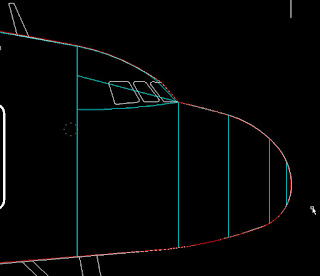 |
| the idea should then consist of a cone with the cockpit on top |
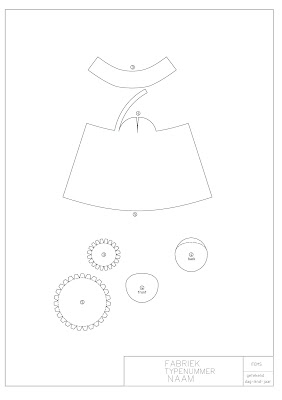 |
| let's give it a try |
 |
| That looks fine! Just lower the lineweight value to get rid of these dark plot lines. |
Was de L-749, PH-FLE niet oorspronkelijk een USA(A)F kist? Vandaar die
afwijkende raampartij
(wasn't the L-749 originally a USA(A)F bird? Thus the deviating windows)
I decided to forget the discrepancies and carry-on using the windows derived from the FLE-pictures below.
 |
| the FLE final shape (white fuselage & cyan windows) versus the L-749 3views (yellow fuselage & white windows) |
Apart from the texturing the fuselage is complete and the only awful routine consits of the 'construction' of the glueing-flap at the bottoms of each section.
I thought it high time to write another piece of QB64-basic code.
 |
| QB64 QuickBasic programme |
One should expect an incorporated LISP-function in DraftSight, but unforunately
this option is granted solely to the professional version of the programme.
The code:
And what is does:
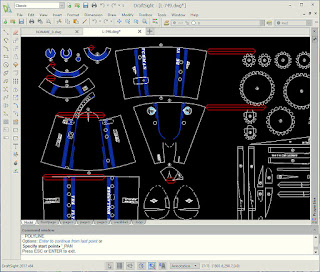 |
| the tags are computed and stored as red-colored polylines in script-files (*.SCR) |
Remaining are the wings, stabilizers, gear, props and other smaller stuff.
 |
| fitting on the A4 like a glove |
Bit by bit the drawing approaches completion but seemingly minor items may become trivial after having finished the model. One such an item I think to have found in the text 'K.L.M' over the portside door at the rear side. I thought the type of characters a bit irregular in comparison with the company's name everywhere else. The available photographs of the FLE-plane were far to unclear to establish the exact shape.
 |
| importing this A2A shot in DraftSight the last hurdle will have been taken |
 |
| consequently applying one wide and one smaller offset this should approach reality |
That's what I thought to do, but in a cursory look I missed some clipped images.
A few trials were enough to find the PDF-printer in the printer configuration had caused this trouble.
Fortunately I could still rely on a very long time used config, the PDF995.
O.k. you're right, spinners and props are still missing. I even fear there won't be space for them ....
The first step building downloaded cardboard models is printing the PDF's:
 |
| the quality of printing depends mainly on the printer (driver) |
 |
| for one reason or the other... teeth.... |
 |
| what we in Holland call 'woodboard' |
You can cut it by passing over the cut several times but I prefer to use my good-old scroll saw. A bit of sanding finishes the job.
 |
| true love never grows old - only a bit smaller and thirteen years later |
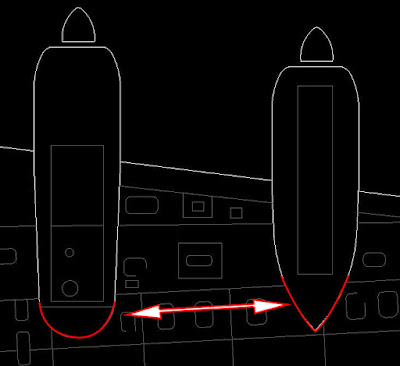 |
| though none of both is in accordance with reality the right shape is quite close |

